REMOTEtional Intelligence
On Demand Course Coming Soon!
About this Event
In this 6-part course, you’ll learn the tactics prescribed in our book (REMOTEtional intelligence) for building result-oriented teams that work seamlessly as remote, hybrid or co-located teams. You’ll learn how 15 emotional intelligence traits can benefit remote workers, managers and teams by enabling remote worker autonomy, building presence, re-imagining performance, building trust, and simplifying the communication process
This engaging, highly informative course delivers 12 PDUs ( 6 Leadership + 2 Technical + 4 Strategy) and includes an opportunity to download a Certificate of completion for claiming PDUs.
Discounted EQ Assessment:
At the time of purchase, you'll have a one-time opportunity to purchase a steeply discounted Emotional Intelligence assessment (EQi 2.0), which includes a personalized 27-page report comparing your emotional intelligence with other professionals, recommendations for improving key areas such as impulse control, assertiveness and emotional self-awareness and a coaching/debrief session with the instructor!
Target Audience:
• Fully remote team members and managers
• Co-located team members and managers
• Hybrid team members and managers
• Remote workers who want to deliver optimal performance
• Managers who want to inspire optimal performance while balancing trust with accountability
Part 1 Topic:
READINESS – Working Independently
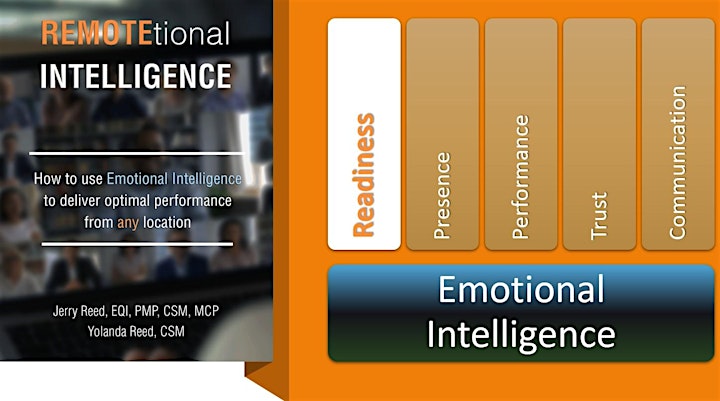
Part 1 Description:
In this module, you’ll learn to assess and enhance your remote work readiness level. You’ll learn why you should and how you can build upon your technical troubleshooting, organizational, planning and time management skills. You’ll also learn effective tactics for building three relevant emotional intelligence skills, including the ability to work more autonomously, the ability to delay emotional reactions and the ability to solve technical and relationship problems by using a structured approach.
Part 1 Learning Outcomes:
• Describe how emotional intelligence can enhance your remote work readiness level
• Identify ten technical areas to enhance for working more effectively from home
• Identify practical solutions to proactively address technical issues
• Identify eight criteria for an ideal workspace
• Gain a competitive edge by receiving an exhaustive work-from home equipment list
• Identify 3 relevant emotional intelligence traits
• Describe effective ways to overcome a disorganized inbox
• Describe effective ways to increase your daily task completion percentage
• Explain why time management in more important in remote work situations
• Describe effective time management strategies
• Describe a structured problem-solving approach
• Learn an effective model for controlling unproductive impulses
• Identify the root causes of over-reliance on others and describe compelling reasons for overcoming them
Part 2 Topic:
PRESENCE – Controlling Perceptions
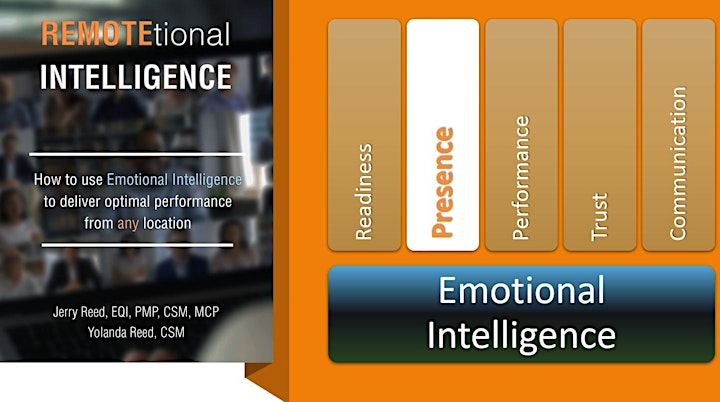
Part 2 Description:
In Part 2, you’ll learn tactics for enhancing your remote work presence level. You’ll learn to control perceptions by projecting a sense of presence, which is the quality of being unseen, but present. You’ll learn tactics for amplifying the three pillars or presence, which are availability (your ability to be used), accessibility (your ability to be reached) and affinity (your ability to be felt). Leaders will learn to project leadership presence by learning strategies for enhancing the way they model leadership behaviors, communicate and appear. All participants will learn effective tactics for building three relevant emotional intelligence traits, including the ability to lead through empathy, the ability to enhance interpersonal relationships and the ability to collaborate more effectively by building social responsibility.
Part 2 Learning Outcomes:
• Describe how emotional intelligence can enhance your sense of presence
• Use your presence indicator more strategically and effectively
• Identify tactics for controlling perceptions concerning your ability to be used
• Identify tactics for controlling perceptions concerning your ability to be reached
• Identify tactics for controlling perceptions concerning your ability to be felt
• Explain effective ways to project leadership presence
• Describe ways to be more decisive
• Describe ways to command the virtual room
• Identify tactics for building interpersonal relationships
• Explain how empathy can de-escalate conflict and amplify presence
• Describe four compelling reasons to become a better teammate
Part 3 Topic:
PERFORMANCE – Re-Thinking Performance
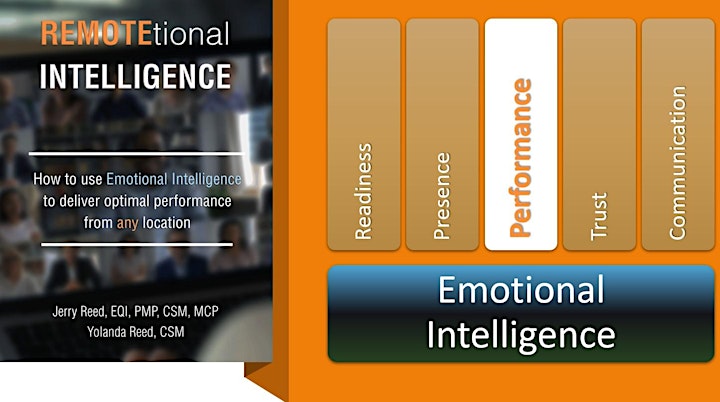
Part 3 Description:
In Part 3, you’ll learn tactics for enhancing your remote work performance level. You’ll be challenged to re-think performance from the lens of remote work and use the SMART goal framework to clearly convey your impact on the business. You’ll learn the value of setting aggressive goals around five objective performance measures and tactics for securing better performance ratings. Leaders will learn to monitor for results rather than for effect. All attendees will learn strategies for building relevant emotional intelligence skills, including becoming more assertive, inspiring stakeholder confidence through optimism and increasing their personal drive to improve.
Part 3 Learning Outcomes:
• Describe how emotional intelligence can enhance your remote work performance level
• Identify five objective, universal performance measures
• Describe tactics for driving ambiguity out of the performance evaluation process
• Describe tactics for securing better performance reviews
• Explain how to apply a “Mamba Mentality” at work
• Explain ways to increase your drive to improve
• Describe effective tactics for building assertiveness
• Identify and avoid three traits of pessimistic thinking
• Exploit the full potential of the SMART goal framework
• Describe performance results in terms of Quality, Quantity, Efficiency, Timeliness and Communication
Part 4 Topic:
TRUST – Closing Trust Gaps – Part 1 of 2

Part 4 Description:
In Part 4, you’ll cover part 1 of a two-part session in which you’ll learn tactics for building high-trust teams. You’ll learn to tailor your trust building strategies to managers and direct reports in each trust quadrant. You’ll learn effective tactics for building trust with professionals with a low trust propensity and sustaining trust with professionals with a high-trust propensity. You’ll learn to select from 12 trust behaviors to build trust with those who are slow to trust and quick to probe, slow to trust and slow to probe, quick to trust and slow to probe and quick to trust and quick to probe. You’ll also learn effective tactics for building three relevant emotional intelligence skills, including the ability to see people and situations as they really are, the ability to adapt to changing circumstances and the ability to inspire trust by exhibiting the right level of self-regard.
Part 4 Learning Outcomes:
• Describe how emotional intelligence can enhance your ability to build trust
• Distinguish safe trust from unprotected trust
• Categorize each stakeholder’s propensity to trust into one of four trust quadrants
• Describe effective strategies for building trust with managers across each trust quadrant
• Describe effective strategies for building trust with direct reports across each trust quadrant
• Enhance your ability to probe more effectively before extending trust by asking ten relevant questions
• Describe compelling reasons to reconsider being slow to trust and quick to probe
• Describe compelling reasons to reconsider being slow to trust and slow to probe
• Describe compelling reasons to reconsider being quick to trust and slow to probe
• Describe effective ways to remain quick to trust and quick to probe
• Explain when it’s advisable to extend the probing period
• Identify ways to recognize biases that may cause you to make poor trust decisions
• Identify ways to be more responsive to changing dynamics which may warrant a different trust posture
• Describe effective tactics to eliminate six negative thought patterns which erode your ability to inspire trust
Part 5 Topic:
TRUST – Closing Trust Gaps – Part 2 of 2
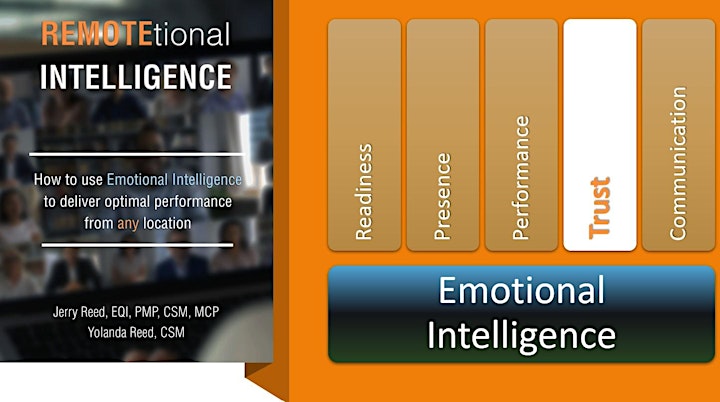
Part 5 Description:
In Part 5, you’ll cover part 2 of a two-part session in which you’ll learn tactics for building high-trust teams. You’ll learn to tailor your trust building strategies to managers and direct reports in each trust quadrant. You’ll learn effective tactics for building trust with professionals with a low trust propensity and sustaining trust with professionals with a high-trust propensity. You’ll learn to select from 12 trust behaviors to build trust with those who are slow to trust and quick to probe, slow to trust and slow to probe, quick to trust and slow to probe and quick to trust and quick to probe. You’ll also learn effective tactics for building three relevant emotional intelligence skills, including the ability to see people and situations as they really are, the ability to adapt to changing circumstances and the ability to inspire trust by exhibiting the right level of self-regard.
Part 5 Learning Outcomes:
• Describe how emotional intelligence can enhance your ability to build trust
• Distinguish safe trust from unprotected trust
• Categorize each stakeholder’s propensity to trust into one of four trust quadrants
• Describe effective strategies for building trust with managers across each trust quadrant
• Describe effective strategies for building trust with direct reports across each trust quadrant
• Enhance your ability to probe more effectively before extending trust by asking ten relevant questions
• Describe compelling reasons to reconsider being slow to trust and quick to probe
• Describe compelling reasons to reconsider being slow to trust and slow to probe
• Describe compelling reasons to reconsider being quick to trust and slow to probe
• Describe effective ways to remain quick to trust and quick to probe
• Explain when it’s advisable to extend the probing period
• Identify ways to recognize biases that may cause you to make poor trust decisions
• Identify ways to be more responsive to changing dynamics which may warrant a different trust posture
• Describe effective tactics to eliminate six negative thought patterns which erode your ability to inspire trust
Part 6 Topic:
COMMUNICATION – Communicating Simply
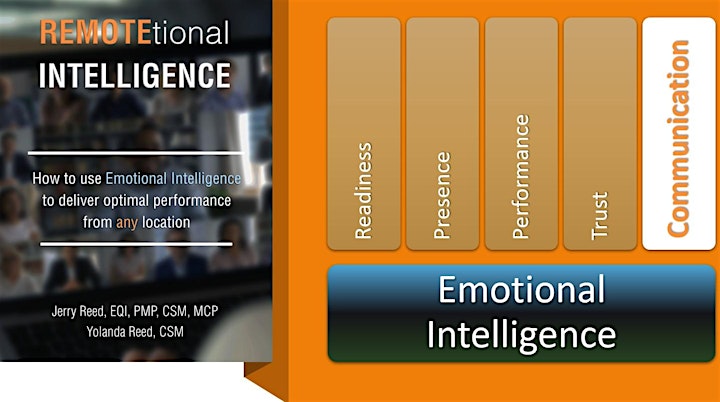
Part 6 Description:
Communication is only effective when the listener’s interpreted message matches the speaker’s intended message. In this session, you’ll learn to communicate effectively in remote, co-located and hybrid work situations by simplifying your message, limiting misinterpretations and closing the gap between intent and interpretation. You’ll learn to dissect the communication process into five key components and improve each component to enhance communication effectiveness. You’ll learn tactics for thinking clearly enough to clarify emotions and intent, interpreting and sending nonverbal messages, caring for the listener, tailoring your message and packaging it in the most effective medium. You’ll also learn effective tactics for building three relevant emotional intelligence skills, including the ability to identify emotions, effectively express emotions and cope with difficult communication exchanges.
Part 6 Learning Outcomes:
• Describe how emotional intelligence can enhance your ability to communicate effectively
• Explain how listeners interpret mixed messages
• Explain the relative importance of verbal and nonverbal messages
• Describe effective tactics for clarifying your emotions
• Describe an effective approach for clarifying and evaluating the intent of your message
• Expand your emotional vocabulary
• Describe effective ways to improve your nonverbal acumen in remote, co-located and hybrid situations
• Describe the gap between speech rate and thought rate and how you can use this gap as a communication helper rather than a communication hurdle
• Explain the importance of caring for the listener in the communication exchange
• Describe ways to build a foundation of care and trust
• Describe tactics for tailoring your message to best serve your communication objective
• Identify 15 media options and broad guidelines for using them
• Describe and draft a communication plan for recurring messages
• Describe effective ways to identify emotions
• Describe effective ways to express emotions
• Describe effective ways to cope with difficult communication exchanges

